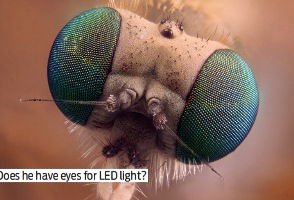Ultraviolet light has been exploited for years to lure flies to an early death by electrocution as can be seen in the bug traps at any supermarket’s fresh meat counter. Over the years I have heard from numerous sources that, because LEDs don’t emit ultraviolet light, they don’t attract insects.

At first glance the statement seems to pass the common sense test. I didn’t start to really question it until I left a retrofit LED bulb switched on to test in my garage for six months, during which time the diffuser accumulated a significant number of corn flies. If there’s no UV, what is it about LEDs that’s so irresistible to insects?
The search for the truth
Spend a little time trawling the internet and you will quickly unearth a wealth of articles, reports and anecdotes on UV light, insects and LEDs, frequently contradicting each other and sometimes with a strong smell of snake oil about them.
A few calls to the UK’s Royal Entomological Society put me on a clearer track, and I was directed to some useful papers on insects and light. Perhaps the most pertinent was undertaken in 2005 at the University of Agriculture in Faisalabad, Pakistan, titled ‘Insect orientation to various colour lights in the agricultural biomes of Faisalabad’.
The research was carried out by erecting a number of illuminated one metre-square screens in two separate locations, each six metres apart, and collecting the insects that became trapped on each panel at half-hourly intervals.
The study revealed that 60-70 per cent of insects preferred blue light. But that doesn’t mean the others stayed at home – insects, as it turns out, have a wide variety of preferences. Eighteen per cent headed for a white light, 8-10 per cent went for yellow and two per cent headed straight for the red light district.
What if you’re the only light in town? Little research has been carried out in the area of general lighting, and more specifically LED. Given a choice between no light and a white light, do insects give up and go home, or do they fly merrily around your head, laughing at your feeble LED fittings and making the occasional landing on your neck to suck your blood?
After the success of my North Yorkshire garage LED trial, I took the opportunity to extend the study to my brand new LED-lit kitchen. I can report that the local midges are more than happy to hang around on a wall under an LED downlight, where they are soon joined by a selection of moths and flies.
And with less radiated heat than traditional light sources, they are far less likely to get burnt. It’s only a matter of time before word gets around in the insect community about this cool new hangout.
Bugged out
It appears that insects, like humans, have quite complex and diverse tastes in lighting, and may well
spend hours debating the colour rendering of a dung heap under different sources.
But, also like humans, they’ll make do with what light there is. I’m sure the option of hanging around in a dimly-lit Starbucks and dive bombing freshly-made cappuccinos is preferable to the risk of being spattered across a truck windscreen on the M25 while trying to find a nice white HID lamp.
So next time Snake Oil Bob drops in to hawk his wares on the basis of their anti-bug properties, send him packing with an LED torch to Faisalabad, and he can explain to the local insects himself that it doesn’t emit any UV – if they’ll stop biting him for long enough to listen.
Click here to register to receive your copy of Lux Review Magazine!
